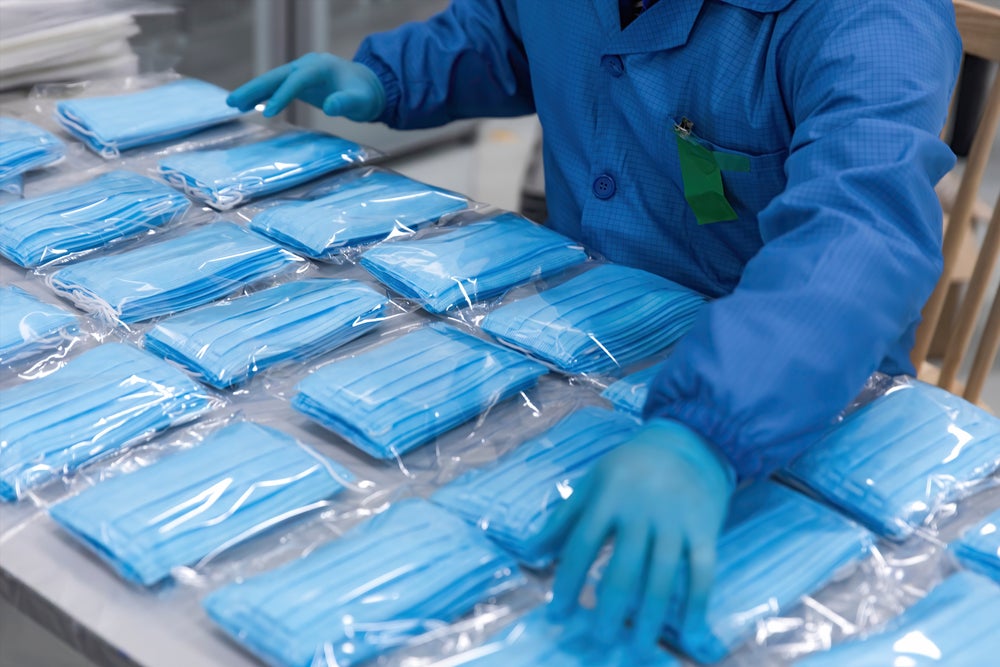 Photo: InkheartX/Shutterstock
Photo: InkheartX/Shutterstock
The rapid escalation of the COVID-19 pandemic has put the global health-care supply chain in the spotlight. As countries establish response strategies, policymakers from various countries have suggested turning inward to make essential goods. Suggestions of nationalizing parts of supply chains, or whole supply chains, however, run counter to empirical evidence of how the industry works.
This blog looks at how the fragmentation of production over the past 20 years and the new manufacturing bases in developing countries have increased—and not diminished—the ability of countries to respond to the unexpected sudden spikes in demand experienced during the coronavirus crisis. We highlight two essential sets of products used in treating everything from minor wounds to cardiac arrest and cancer: (i) protective and personal equipment (PPE), a wide range of health and safety products, predominantly low-value single-use items such as facemasks, gloves and gowns; and (ii) medical devices (MD), covering more sophisticated and technology-intensive equipment, including mechanical ventilators and very high-value items such as MRI scanner machines.
Reason # 1: Booming global demand has driven the globalization of medical supplies and devices in recent decades; traditional exporters have seen their exports surge over this period, but non-traditional exporters have grown even more.
Since 2008, global trade in PPE and MD has more than doubled in value (UN Comtrade, 2020). The driver was a large increase in demand, which resulted from greater health-care expenditure in the developing world and from aging populations in both rich and middle-income countries.
Exports from traditional locations (i.e. Belgium, Canada, France, Germany, Italy, Japan, the Netherlands, United Kingdom, United States) have increased by 45 percent since 2008 (Figure 1). Meanwhile, non-traditional exporters have grown twice as fast (100 percent), both from large, newly industrialized, global manufacturing hubs (China, the Rep. of Korea and Mexico), and some smaller, specialized locations (Costa Rica, Malaysia, New Zealand and Singapore) (Hamrick & Bamber, 2019).
In the current situation, essential PPE such as facemasks, gowns and gloves are produced predominantly in developing countries, while MDs are made mainly by companies in developed nations (Figure 1). Yet, most non-traditional exporters have grown faster in both categories (Figure 2). In all of these products, the degree of interdependency between countries has grown. For example, the number of bilateral trade relationships in facemasks of the N95 type (HS 9020) increased from 1,835 in 2002 to 3,521 in 2019.
Figure 1. Exports of medical supplies and devices, 2008 and 2018
Figure 2. Traditional and non-traditional PPE and MD exporters, CAGR 2008-18
Reason #2: While global production has increased, outsourcing in the industry has been very limited and leading firms from developed countries dominate global supply.
The global trade in medical devices is led by large, multinational vertically integrated firms headquartered in traditional manufacturing locations with worldwide production facilities. Very few lead firms have emerged thus far from non-traditional locations. They have developed global platforms to access the new demand in emerging markets, while at the same time diversifying risk and leveraging complementarities in the supply chain capabilities of different locations (Bamber & Gereffi, 2013). Table 1 lists the leading firms for key COVID-19 products.
Yet, unlike many other industries, contract manufacturing has been slower in PPE and MDs due to strict regulatory oversight regarding quality and performance. Given the life-and-death consequences relating to MDs, lead firms must therefore maintain the highest levels of control over their supply chain, and thus prefer to keep it in-house. All factories, for example, must be ISO:13845 certified to sell medical devices to major markets—a costly and time-consuming process (Hamrick & Bamber, 2019). Nonetheless, they still depend on others for raw materials and non-critical components. PPE is less technologically sophisticated and faces lower regulatory barriers than MDs, leading to increased external contracting, but certification remains fundamental.
Table 1. Leading firms by key product segment
| Product Segment |
Firms |
| BD (US), Philips (Netherlands), Hamilton Medical (Switzerland), Fishel & Paykel (NZ), Draeger (Germany), Medtronic (Ireland), GE Healthcare (US), Smiths (UK), Resmed (US), Maquet (Germany) |
|
| Honeywell (US), 3M (US), Kimberly Clark (US), Foss Performance Materials (US), Prestige Ameritech (US), Alpha Protech (US), Louis M. Gerson Co. (US), Makrite (Taiwan China), Moldex-Metric, Inc.(US), Shanghai Dasheng Health Products Manufacture Company (CN), Aero Pro Company (Taiwan China) |
|
| Top Glove (Malaysia), Ansell (Australia), Hartalega (Malaysia), Kossan (Malaysia), Supermax (Malaysia) |
Sources: (Bell, 2020; Hamrick & Bamber, 2019; Henneberry, 2020; LD Investments, 2019)
Reason #3: Since COVID-19 erupted, global supply chains have helped to smooth severe shortages experienced by the most severely infected countries.
Since the spike in demand for these products following the COVID-19 crisis, developing countries’ production has helped to smooth the pronounced shortages experienced by the most severely infected countries.
China has been the source of about half of the imports of PPE into the United States and the EU (Bown, 2020). Chinese exports of essential PPE supplies declined by 15 percent in the first two months of 2020 (compared with 2019), when domestic demand for these products spiked in response to coronavirus, but this contraction was less than the 17 percent drop in other Chinese exports during the same period. Since then, China has rapidly scaled up the production and export of facemasks, hospital gowns and even MDs such as ventilators. By late March, China was making 116 million masks a day, 12 times its supply prior to the outbreak (Bown, 2020).
Furthermore, at very short notice, buyers around the world have been able to find alternative sources of supply from other non-traditional exporters, for example, importing gloves from Sri Lanka and Thailand, and hospital gowns from the Dominican Republic, Honduras and Vietnam (UN Comtrade, 2020).
Reason # 4: The massive scaling-up of supply during the COVID-19 crisis is challenging from a pure production and processing perspective. Leveraging inter-firm relations to disseminate know-how and ensure international coordination on regulations can speed up responsiveness.
Many companies are ramping up production, but none can keep up with demand and all are obliged to extend their delivery times. As a result, firm partnerships are being created to help expand the production of existing devices and bring new innovative solutions to the table. New manufacturing arrangements include Ventec Life Systems partnership with GM to help the firm meet its Defense Protection Act requirements to produce 30,000 ventilators by the end of August, and 3M with Cummins to develop HEPA filters for its respirators (3M, 2020; Assis, 2020; Criddle, 2020).
High demand for inputs has also spurred innovations among new players (Chambers, 2020). Here, firm-to-firm relationships are also key. The Mercedes-Benz Formula 1 team partnered with University College London to develop a new design for mass-produced ventilators, already producing 1,000 units a day and open-sourcing its design (F1, 2020). UK vacuum manufacturer, Dyson, partnered with TPP to design a brand-new ventilator in just 10 days to supply the UK NHS, manufacturing the motors in Singapore (Sajan, 202). Virgin Orbit, an aerospace technology firm, developed a simple way to “mechanize” manual ventilators with an easily produced pump (Virgin Orbit, 2020).
But scaling up production, and even more so bringing in new producers and new products, is full of challenges. Staffing factories with skilled/trained personnel and accelerating supply chains takes considerable time. First, scaling up production involves major shifts in firm personnel and factory configuration (Rachal, 2020). This includes doubling shifts, hiring and training new workers, or transferring them from other facilities (Honeywell, 2020). Hamilton Medical, for example, is putting its marketing staff on production lines (Miller & Pollina, 2020). This is not easy when many production locations themselves are in quarantine. In all these cases, easing regulation on international trade and labor mobility has been part of the solution, not the problem. Resmed, in Singapore, whose operations depend on Malaysian workers, could scale up its global response only when the Malaysian government allowed more labor mobility.
In some cases, raw materials and components are not readily available because these too are sourced globally. For example, Chinese ventilator manufacturers have been able to overcome staffing challenges as China goes back to work, but they must source key components from Europe (Miller & Pollina, 2020). With European manufacturers under lockdown, this has created major bottlenecks. Contingency plans, more diversification of production locations and suppliers, and prompt government action to ease strict regulatory and quality requirements all help in overcoming the bottlenecks. On the other hand, re-shoring or near-shoring reduces the range of options in facing unpredictable shocks.
Parts are also caught up in government export bans of critical medical equipment (ITC, 2020). Hamilton Medical needed the Swiss consulate to intervene on its behalf to allow the export of ventilator hoses from Romania, despite the fact that these hoses alone were of no use to Romania without the corresponding machines.
Policy Implications
This crisis highlights the profound global interdependency of the health-care sector. Nations need to understand this if they are to effectively fight the COVID-19 pandemic. The lesson from the challenges and responses in the PPE and MD industries is that even greater gains can be had than in normal times from coordinated action to contain the disease and mitigate the effects. In contrast, going it alone only makes the response more challenging.
The industry’s globalized production base provides a strong diversified foundation on which to source vital items for the health-care sector. The two main shortages for protective and lifesaving equipment can be addressed by two distinct sets of countries. Less complex PPEs, such as face masks, gowns and gloves, are produced predominantly in middle-income countries (non-traditional exporters). Without these necessary consumables, major developed countries will struggle to prevent infections, especially among medical staff, increasing the need for ventilators as more people fall sick. On the other hand, lifesaving ventilators are made primarily by traditional, high-income, exporters. Without these ventilators, developing countries will struggle to curb the death rates, even if they can use their protective gear to slow infection.
To keep these GVCs functioning at maximum capacity, it is important to: (i) allow international free flows of goods; (ii) permit the movement of essential labor across borders; and (iii) facilitate trade logistics, for instance fast-tracking customs clearance of not only final products but also vital intermediate ones. And above all, think twice before moving to nationalize any parts of the supply chain.






Join the Conversation